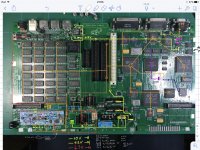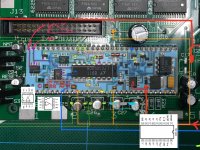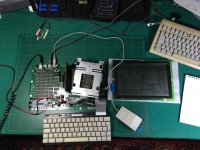Mc128k
Active member
Hi everybody
I recently obtained from a friend a Macintosh Portable in perfect conditions, and I am currently trying to bring it to life (even if it's useless! Yes, I am wasting my time, got a problem?). It's the very first model, the one with no backlight.
First thing first, I disassembled it, and it was a joy. Found immediately a huge leak from the 9V battery, that hurted the logic board underneath a bit.
Washed, cleaned with isopropyl alcohol and fully recapped. About the power supply, I am using the lower right connections (the test pads) to deliver about 6.5V with a lab power supply limited to 2A (tried with the red cable first, and then I saw it's the same thing).
The machine can actually power on (I'll omit various steps I tried to power it on, because I really lost hours into this repair), but after one second it shuts down. No signs of life, no PRAM fix. I have to disconnect the power, wait a few seconds, and then reconnect it again.
So.. I decided to try reverse-engineering the power circuits. Here is the result so far:

It seems that the portable has a linear regulator for the 5V line, and a switching boost converter for the 12V hard disk power. The problem is that what is seemingly 5V (orange line) reads 6.5V (the power supply voltage). So the Q16 P-MOSFET is completely open. Bad.
The gate measures almost 0 volts, that means that Q16 is not receiving the correct signal I think. Who gives that signal? U1M
Also I can see with an oscilloscope (a piece of junk actually) that Q20 starts high (so it's off) and then it starts oscillating at about 2V when the machine powers off. No problem, it seems to be only related to the hard drive (5V probably).
In the hybrid IC U1M, the upper right controller drops the voltage at the shutdown point, the FET below it stops delivering power.
Now, I believe I did something wrong here. I don't know what because I experimented a lot with this board. I can just say that it's surely a power issue because I have seen it working with the original hard drive in one particular test (it loaded the OS!), and after that it stopped. Maybe one of the tests burned some op-amps, I don't know and I have no way of testing it.
There is no schematic and the board is multi-layered. This makes any reverse engineering work a hassle. I hope this partial schematic could come useful to somebody.
I already read a large number of posts and seen some troubleshooting videos. Cannot get any clue, my electronics debugging skills are poor here.
Maybe it's time to call for help. I'm really stuck here, and I see no way out (building a separate power supply and disabling the board mosfets is too extreme). Any help would be useful, I'm not a noob and I'm not asking for step-by-step instructions. Just some hints on where to look for issues.
[Probably someone is going to say that it's the hybrid IC. Hooray! Not helping]
Thanks
[EDIT]
Also checked and rebult some VIAs in the upper left part where the chip is missing (this is a work-in-progress picture, I didn't connect it like that).
The speaker crackles if I use the MOLEX plug (which shorts the first two 6.5V contacts), and it works fine if I power directly 5V to the orange line. Unfortunately some of these tests made Q16 emit a buzzing noise (disconnected immediately of course), like a circuit was oscillating in a bad way; it's alive then..?
I recently obtained from a friend a Macintosh Portable in perfect conditions, and I am currently trying to bring it to life (even if it's useless! Yes, I am wasting my time, got a problem?). It's the very first model, the one with no backlight.
First thing first, I disassembled it, and it was a joy. Found immediately a huge leak from the 9V battery, that hurted the logic board underneath a bit.
Washed, cleaned with isopropyl alcohol and fully recapped. About the power supply, I am using the lower right connections (the test pads) to deliver about 6.5V with a lab power supply limited to 2A (tried with the red cable first, and then I saw it's the same thing).
The machine can actually power on (I'll omit various steps I tried to power it on, because I really lost hours into this repair), but after one second it shuts down. No signs of life, no PRAM fix. I have to disconnect the power, wait a few seconds, and then reconnect it again.
So.. I decided to try reverse-engineering the power circuits. Here is the result so far:

It seems that the portable has a linear regulator for the 5V line, and a switching boost converter for the 12V hard disk power. The problem is that what is seemingly 5V (orange line) reads 6.5V (the power supply voltage). So the Q16 P-MOSFET is completely open. Bad.
The gate measures almost 0 volts, that means that Q16 is not receiving the correct signal I think. Who gives that signal? U1M
Also I can see with an oscilloscope (a piece of junk actually) that Q20 starts high (so it's off) and then it starts oscillating at about 2V when the machine powers off. No problem, it seems to be only related to the hard drive (5V probably).
In the hybrid IC U1M, the upper right controller drops the voltage at the shutdown point, the FET below it stops delivering power.
Now, I believe I did something wrong here. I don't know what because I experimented a lot with this board. I can just say that it's surely a power issue because I have seen it working with the original hard drive in one particular test (it loaded the OS!), and after that it stopped. Maybe one of the tests burned some op-amps, I don't know and I have no way of testing it.
There is no schematic and the board is multi-layered. This makes any reverse engineering work a hassle. I hope this partial schematic could come useful to somebody.
I already read a large number of posts and seen some troubleshooting videos. Cannot get any clue, my electronics debugging skills are poor here.
Maybe it's time to call for help. I'm really stuck here, and I see no way out (building a separate power supply and disabling the board mosfets is too extreme). Any help would be useful, I'm not a noob and I'm not asking for step-by-step instructions. Just some hints on where to look for issues.
[Probably someone is going to say that it's the hybrid IC. Hooray! Not helping]
Thanks
[EDIT]
Also checked and rebult some VIAs in the upper left part where the chip is missing (this is a work-in-progress picture, I didn't connect it like that).
The speaker crackles if I use the MOLEX plug (which shorts the first two 6.5V contacts), and it works fine if I power directly 5V to the orange line. Unfortunately some of these tests made Q16 emit a buzzing noise (disconnected immediately of course), like a circuit was oscillating in a bad way; it's alive then..?
Last edited by a moderator:



